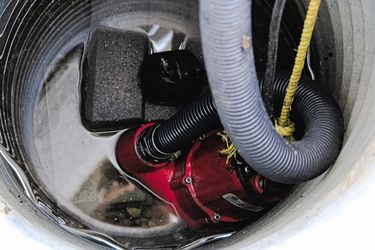
Written by Kayla Jane Barrie Updated on Dec 10, 2025 5 mins read

Sump pumps are one of the best ways to prevent water damage in Canadian homes. But how exactly do they work and how do they prevent damage from water in your home?
Water can have a devastating impact on your home, and basic policies do not include flood insurance. Statistics Canada found that over 17,000 buildings and living areas are at a risk for flood damage from rain, snowmelt, and other weather related disasters.
Not all homes have sump pumps, but here’s a look at when you should consider adding additional coverage to your home insurance and how to maintain it properly.
A sump pump is a submersible device installed in a sump pit dug at the lowest point of your home, usually the basement, designed to collect water that filters through the loose earth outside your home. Not all homes have sump pumps – if you live in a dry area or the builders did not consider one a necessary addition, you likely wouldn’t have one.
This small but mighty piece of equipment has countless benefits, including :
If you have a finished basement, previous water problems, or live in a location with heavy rain or snow, you may want to consider investing in a sump pump if there is not one already.
Having a sump pump can not only protect your home from flooding, but it can also lower your coverage costs. Since a sump pump lowers your risk for a claim, some insurers offer discounts for your due diligence to mitigate potential accidents. Give our licensed brokers a call to learn if you qualify for a deduction in your policy or if you should add sewer backup insurance.
If your sump pump experiences an accidental failure that damages your home, you’ll only be covered if you have water damage insurance or another endorsement supporting related damages. Often, policies will not cover the sump pump repair or replacement in the event of a claim, but always check with your provider to confirm if it’s included.
Insurance companies will cover the damage caused by the water, but they will not cover the source of the damage, such as the sump pump. The homeowner will be responsible for paying the deductible and replacing the sump pump, which also includes hiring a plumber to repair or replace the sump pump.
If you are installing a sump pump to prevent future mishaps, your insurer may be able to assist you with the costs. This decision will vary by each insurer, but it is worth asking before you begin the project.
Some towns and cities may offer a sump pump installation rebate. For instance, in Toronto the Basement Flooding Protection Subsidy Program offers up to $3400 if you install a flood protection device in your home.
There are two types of sump pumps - primary or backup. Ideally, your home has one of each because the backup sump pump will kick in if the primary fails, or if the water intake is too high to handle. There are combination sump pumps available for purchase.
There are also two different types of sump pumps for Canadian homeowners – submersible and pedestal.
When you get a sump pump installed or repaired, you’ll want to work with an expert to determine the flow rate and the correct distance for optimal flow.
One of the most important features to invest in, especially to lower your home insurance costs, is a backup power source. Here is a look at the options.

Sump pumps are designed to move water from your home and divert it safely away from the foundation of your building. They are pits dug into the basement that collect water with the assistance of sensors and other mechanics.
Once the equipment is activated, it uses about one gallon of city water to pump two gallons from the pit. A total of three gallons will be removed from your home, reducing the risk of flooding. The amount of water being diverted will depend on the type of pump you have.
Since intense rainfall and weather can cause power outages, many pumps have battery backups to ensure they continue functioning. Even with a sump pump, overland flood insurance is a highly suggested endorsement for your policy.
Sump pumps work by collecting rain and flood water from your home. When the water reaches a certain level, the float activator triggers the pump, causing the pit to empty of water. Once it is activated, the pump will move water through the discharge pipe to outside your home.
There is also a motor which is powered by electricity, and some models have a backup battery, which will ensure your equipment keeps working even if there is a power outage.
Once a sump pump is installed, it’s important to follow a few steps to keep it working properly. By following these six tips, you can be sure yours is working the next time you do your autumn or spring home maintenance checklist.
If you have any issues or questions, contact a reputable technician to take a look at your system.
A sump pump replacement will cost between $28 and $500, depending on the type you replace it with. If you do the project yourself, it will keep costs lower compared to hiring someone to do the work. Depending on the damage, your Ontario home insurance may help with replacement or repairs.
On average, sump pumps last 10-15 years. The lifespan of your water heater is influenced by the level of dirt and acidity in the water in your area. Keep an eye on your system - if you notice any malfunctions or delays in functionality, it may be time for a new pump.
If you’ve ever had your basement flooded, live in an area that receives heavy snow/rainfall, or live in an area with a high risk of flooding, you should consider installing a sump pump. You can check out the Canadian flood map of high risk areas.
Sump pumps play a crucial role in keeping excess water out of your home. Some insurers will offer a discount on specific setups and for having a battery backup model. Please speak to our experts to ensure you are optimizing savings and safety on your next water damage insurance.
| Categories | Home |
|---|---|
| Tags | Home CoverageProtect Your HomeHomeowners Claims |
Read our insurance blog to get helpful tips, information and news.
Has your car been totalled in an accident? Is your car a write off? Learn about vehicle write offs for a total loss insurance claim.
Get the facts on Toronto's auto theft problem. We break down the data, reveal the most-stolen vehicles (including the Honda CR-V and Lexus RX 350), and show which neighbourhoods are most affected.
Dive into the world of auto theft with our blog on the most stolen cars in Canada. See the most stolen cars across Canada, including provincial lists for Ontario and Quebec, and learn how high-risk models can affect your car insurance premiums.
Drive safe this winter! Check out these tips for driving in snowy and icy conditions in Ontario. Get other helpful info and FAQs on winter driving.